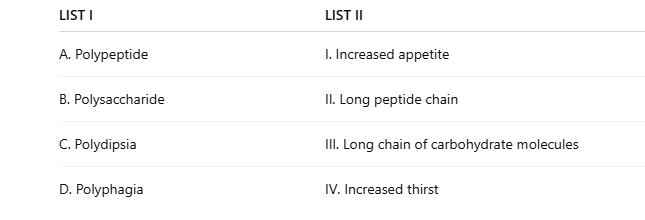Correct option is D
1.
Nephritic Syndrome (A):
·
IV. Inflammation in the capillary loops of the glomerulus Nephritic syndrome is a condition that causes
inflammation in the glomeruli (the tiny blood vessels in the kidneys), which impairs kidney function and leads to symptoms like hematuria and hypertension.
2.
Hypertrophy (B):
·
III. Increase in tissue size by an increase in cell size
Hypertrophy refers to the increase in the size of an organ or tissue through the enlargement of its cells, often seen in muscles or other tissues under stress or overuse.
3.
Hyperplasia (C):
·
I. Increase in tissue size by an increase in the number of cells
Hyperplasia involves the
increase in the number of cells, leading to the enlargement of an organ or tissue. This is typically seen in tissues undergoing normal physiological growth or in response to stress or injury.
4.
Acute Renal Failure (D):
·
II. Sudden oliguria
Acute renal failure is characterized by a
sudden reduction in kidney function, which often manifests as
oliguria, a condition where urine output is significantly decreased.
Information Booster:
·
Nephritic Syndrome is caused by
glomerular inflammation, leading to reduced kidney function and often resulting in blood in the urine (hematuria).
·
Hypertrophy and
Hyperplasia are both forms of tissue enlargement, but hypertrophy involves
larger cells, while hyperplasia involves an
increase in cell number.
·
Acute Renal Failure is usually accompanied by
sudden oliguria, a key diagnostic feature where there is a sharp decrease in urine output.






 English
English 50 Questions
50 Questions 60 Mins
60 Mins


